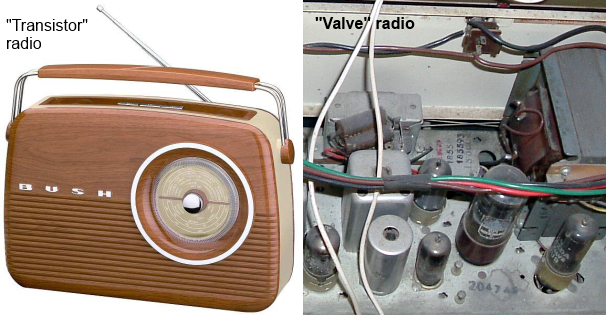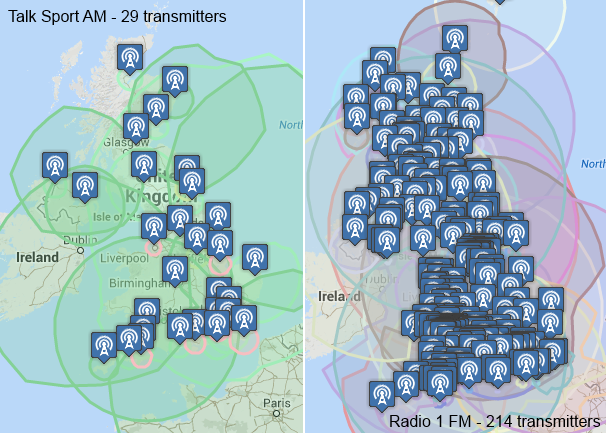The end is near for analogue radio... radio gets very high
 Brian Butterworth published on UK Free TV
Brian Butterworth published on UK Free TV One interesting characteristic of radio signal that are transmitted in the Medium Waveband is that the signal is carried in two ways, both of which are useful.
One is called a "ground wave", which means the signal follows the curve of the Earth. This means that the receiver and transmitter do not need to have a line-of-sight. So it is possible for a medium wave transmitter can serve a radio set 500 miles or more away. For example the old BBC World Service transmitter at Orfordness on 1296 kHz at 1.9MW could serve Belgium, the Netherlands, Luxembourg, north-east France and north-west Germany.
Another feature of Medium Waves that, at night, they also make "sky waves". After dark, the signals reflect off ionosphere (if the mid-layer ionization is strong) like a mirror. So, for example, Orfordness could be received in much of Europe at night. For this reason, AM radio station have to lower their power output after dark. Long Wave radio signals do not reflect.
The benefit to broadcasters of operating a low number of medium wave transmitter sites is offset against the need to guard for interference from other broadcasters long distances away. Even low-power stations daytime stations can become the source of interference many times their usual coverage area.
To this end, there has to be international co-ordination of frequencies and power output levels for Medium Wave and Long Wave. The agreements put stations at 9 kHz apart from each other. Between 531 kHz and 1611 kHz there are 118 "slots", 75 of which are used in some way in the UK. Some of these are for national "single frequency networks", such as Absolute Radio 1215 kHz and sometimes for a single fill-in station such as BBC Radio Scotland (AM) 585 kHz at 1.2kW at Dumfries.

The BBC gets high
The limitations of Medium Wave transmission didn't just limit the number of stations that could be broadcast. Spacing stations 9kHz also means that the there was a limit to the quality of sound, as human hearing ranges up to 2kHz, and the signals using AM were mono. Whilst the 9kHz range is fine for listening to a single human voice (Voice Fundamentals - Human Speech Frequency), it isn't very good for theFrequency Modulation was patented in 1933, but the BBC only started using the system for broadcasting radio in 1955. However this time the Very High Frequency range was used for transmission (from 88.0 to 94.6 MHz).
The FM provides a much better bandwidth - the mono signal goes up to 15 kHz. The system has also been enhanced by the addition of by two stereo "difference" signals, both 15 kHz wide, but this addition is susceptible to noise and multipath distortion and FM radios will flip back to mono when the signal is weak.
The benefit to the quality and reliability of an FM radio signal are clear, but the broadcaster has to provide a large network of lower power transmitters. For example, Radio 1 FM has 214 FM transmitters, whereas TalkSport, using the old Radio 1 MW network, has 29 AM transmitters.

However, the smaller wavelength of higher frequency transmitters means that FM transmitters can be mounted onto existing transmitter masts (such as those used for UHF television or mobile phone masts) and multiple services can be provided from the same location.
However, FM does have drawbacks. The initial design of the networks assumed that a rooftop aerial and home listening would occur. Most masts were changed to "mixed polarization" to allow for mobile and in-car listening.
FM took off when commercial radio started in the UK, and now most analogue listening is to VHF.
The benefits and drawbacks of FM
FM radio is seen by some as a "gold standard" of broadcasting.It is certainly true that compared to AM, with it "spooky sounds".
The CD is a good measure reference: with two-channel 16-bit PCM encoding at a 44.1 kHz sampling rate per channel, and thus a
FM/VHF is limited to 15 kHz, and the stereo signal is provided in two subcarriers, rather than as two independent signals (known as "joint stereo"). If the FM signal is weak the receiver will switch to the mono signal.
The addition of the RDS system FM transmission and to car radios means that modern in-car tuners can, using a second tuner, test all the possible reception frequencies for the channel being listen to and automatically switch to the best. This prevents frequent re-tuning whilst driving.
However, on main drawback remains: there are a limited number of national stations you can put out on FM. Radio 2 uses 88.1 to 90.2, which is 22 "slots", Radio 3 from 90.2 to 92.6, Radio 4 FM from 92.5 to 96.1 (as well as some of 103.5 to 104.9), Radio 1 from 97.1-99.8, Classic FM from 99.9 to 101.9, with a host of local stations using 96.2-97.0 and 102-107.9MHz.
You can explore the frequencies for yourself here:
List of all analogue radio frequencies - ukfree.tv
In the modern world, this limited choice has found solutions in digital radio.
More tomorrow in Part 3, where we look at the development of satellite, Freeview, online and DAB radios.
10:11 PM
The above comments all seem to assume that Analogue Radio on VHF/FM is doomed.
Hence widespread concern at the possible
loss of this popular platform.The words
Analogue Radio also embrace LW & MW,
and if it is just that that is under threat there
may not be so many fears especially if
those channels were re-located to a better
quality platform.
The argument that VHF/FM cannot accomodate extra channels may not be
relevent when more and more channels
are available on satellite and freeview
and Smart TVs (off line) )and there is plenty
of bandwidth there for those LW/MW
analogue channels.
| link to this comment |
10:46 PM
Dennis: I think your missing the point of the move to satellite/freeview, etc. Whatever platforms they are, they are not analogue.
As Mark pointed out on another thread, the amount of digital listening is increasing steadily (5%up from 2012-3, 2.5% of that in just the final three months), and if your listening on digital (via TV, internet, DAB, etc) - your not listening on analogue, be it LW, MW or FM. Its a zero sum game.
Its not just about the extra channels, its about the commercial logic of paying to broadcast programmes on two different systems. If I can listen digitally to a station previously on LW, I can do the same thing to a station currently on FM - so why broadcast on FM?
| link to this comment |
6:08 PM
Doug:
"DAB is not the answer - system is ridiculously power hungry sets eat batteries - less than 8 hours from a new set is just not on! And quality is so poor compared to FM."
Which sets are you referring to here? The early DAB sets were power-hungry but many of the latest portables from Pure & Roberts will run for 100+ hours on a set of batteries.
| link to this comment |
9:48 AM
I think people who promote DAB are conveniently forgetting about quality. Who wants to listen to music on a device that produces a sound little better than that which emanates from a smartphone? The government forces these things on to us for purely financial reasons with no choice or thought for the consumer.
The difference in analogue and digital is really noticeable, right from the times when recording studios went digital; and there are still perfectionists who spend a lot of money on analogue equipment for that very reason.
And what keeps getting forgotten is the fact that there are million upon millions of FM radios out there, in cars and in homes that would not be able to receive the main BBC radio broadcasts. Are all those listeners suddenly going to rush out and update their equipment; I think not? They'll either swap to local stations, that I believe will be the only thing left on the FM band, or simply stop listening to radio.
| link to this comment |
MikeG: Not at all. It is you who overlooks that the public want choice - I covered this in The end is near for analogue radio... Part 3, satellite Freeview online and DAB | Digital radio | ukfree.tv - 11 years of independent, free digital TV advice ,
| link to this comment |
7:02 PM
What about unusable DAB in cars? and I cant believe one long wave transmitter costs more than many DAB transmitters and the world service needs long wave still!
| link to this comment |
steve tames: DAB works fine in cars. The Action Plan is going to have better-than-FM coverage on major and minor roads throughout the UK.
The BBC World Service no longer transmits on Long Wave...
| link to this comment |
9:20 PM
Thats funny, I listen to long wave world service most nights and have you tried a car radio on the M3 near Basingstoke. Even FM struggles. I an put up with some signaldrop outs but not pixelation type effectson audio which take a while to recover.
| link to this comment |
5:58 PM
steve tames:
The World Service is used as a sustaining service when Radio 4 LW closes down overnight (between 1-5.30am).
There is a very small number of people listening to these broadcasts.
For the times when most people listen to the radio (in the daytime) you need digital for the World Service.
| link to this comment |
10:48 PM
Bristol
@ Steve Tames - I've never had any trouble with DAB on the M3, or with FM, though I haven't listened to FM for ages. The areas where I'd like to see improvements are to DAB coverage on the A36 Warminster Bypass and the B390 that cuts across Salisbury Plain from Codford in the west to Shrewton in the east, via Chitterne.
| link to this comment |
Charles's: mapC's Freeview map terrainC's terrain plot wavesC's frequency data C's Freeview Detailed Coverage